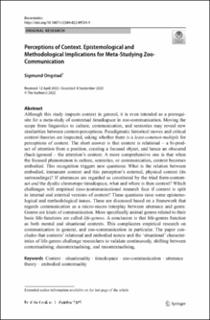| dc.description.abstract | Although this study inspects context in general, it is even intended as a prerequisite for a meta-study of contextual time&space in zoo-communication. Moving the scope from linguistics to culture, communication, and semiotics may reveal new similarities between context-perceptions. Paradigmatic historical moves and critical context theories are inspected, asking whether there is a least-common-multiple for perceptions of context. The short answer is that context is relational – a bi-product of attention from a position, creating a focused object, and hence an obscured (back-)ground – the attention’s context. A more comprehensive one is that when the focused phenomenon is culture, semiotics, or communication, context becomes embodied. This recognition triggers new questions: What is the relation between embodied, immanent context and this perception’s external, physical context (its surroundings)? If utterances are regarded as constituted by the triad form-content-act and the dyadic chronotope time&space, what and where is then context? Which challenges will empirical (zoo-)communicational research face if context is split in internal and external versions of context? These questions raise some epistemological and methodological issues. These are discussed based on a framework that regards communication as a micro-macro interplay between utterance and genre. Genres are kinds of communication. More specifically animal genres related to their basic life-functions are called life-genres. A conclusion is that life-genres function as both mental and situational contexts. This complicates empirical research on communication in general, and zoo-communication in particular. The paper concludes that contexts’ relational and embodied nature and the ‘situational’ characteristics of life-genres challenge researchers to validate continuously, shifting between contextualising, decontextualising, and recontextualising. | en_US |

